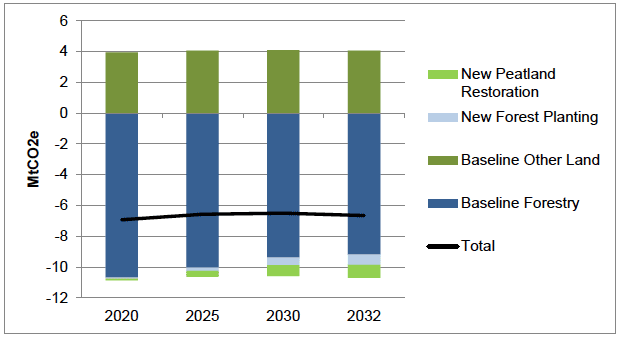Climate Change Plan: third report on proposals and policies 2018-2032 – technical annex
This annex provides an overview of the analysis underpinning the Climate Change Plan
Land Use, Land-Use Change and Forestry (LULUCF) Sector
Sector Overview:
The LULUCF sector is a carbon sink throughout the period of the Plan. The sector includes:
- Baseline woodland creation
- Baseline carbon capture in harvested wood products
- Baseline other land use and land-use change, comprising:
- Settlements
- Indirect nitrous oxide emissions from managed soils
- Cropland
- Grassland
- Wetlands
- Afforestation
- Peatland restoration
Data Inputs:
Projected future baseline land use areas and emissions were provided by BEIS, consistent with their Updated Emissions Projections [11] , and are taken from analysis from the Centre for Ecology and Hydrology ( CEH).
Afforestation rates are as advised by the Forestry Commission and future peatland restoration rates are as advised by the Rural Environmental Science and Analytical Services team in Scottish Government.
Additional constraints since the Draft Plan:
Since the draft Climate Change Plan, we have made a number of updates to the TIMES model, in addition to incorporating the latest historic GHG Inventory data.
The draft Plan was based on baseline emissions and land use projections produced by CEH in 2013, which, at the time of publication of the draft Plan, were the most up-to-date projections available.
We have now updated the baseline emissions and land-use projections used in TIMES to reflect a number of recent data developments.
The 2015 Greenhouse Gas Inventory, published in June 2017, included a number of changes to the treatment of historic LULUCF emissions. These included:
- Using the National Forest Inventory dataset (2011-2015), rather than the less timely National Inventory of Woodland and Trees (1995-99)
- Including woodland between 0.1 and 0.5 hectares in area
- Including carbon stock changes in biomass from cropland management and grassland management
- Incorporating revisions around planting on organic soils
The new emissions and land-use projections, which were provided by BEIS and produced by CEH, and used in the final Plan, incorporate the above changes, as well as further changes, including:
- Previously, CEH assumptions did not consider that trees are planted on soil that is covered with plants and litter from ground vegetation, which sequester carbon. They have now included these assumptions in the model, recognising that while planting trees will lead to emissions from the soil, this will be balanced by the carbon sequestration by these plants and litter on the soil
- The CEH has also made changes to the assumptions used in incorporating small woodland (0.1-0.5 hectares) in their modelling
The above changes will be reflected in the 1990 - 2016 GHG Inventory, alongside other updates, which will be published in June 2018.
The new projections, together with a slight amendment to peatland restoration rates, increase the scale of the carbon sink across the LULUCF sector by approximately 6 MtCO2e on average, relative to the sector data used in the draft Plan.
CO 2 removals from woodland planting which would have occurred without policy intervention were removed from the new planting figures to avoid double-counting baseline afforestation.
Results:
Total net removals for the sector reach 6.9 MtCO 2e in 2020, which is largely due to baseline forestry removals of 10.7 MtCO 2e in 2020. Total net removals fall slightly to 6.5 MtCO2e by 2030, due to a fall in baseline forestry removals and a slight increase in emissions from other land. Total net removals increase to 6.7 MtCO 2e by 2032, due to an increase in removals from afforestation and peatland restoration.
Figure 19: Breakdown of Emissions/Removals for LULUCF Sector ( MtCO2e), TIMES model results

Contact
There is a problem
Thanks for your feedback